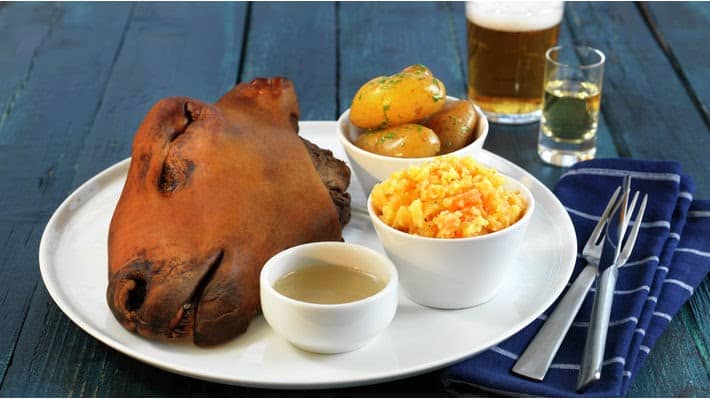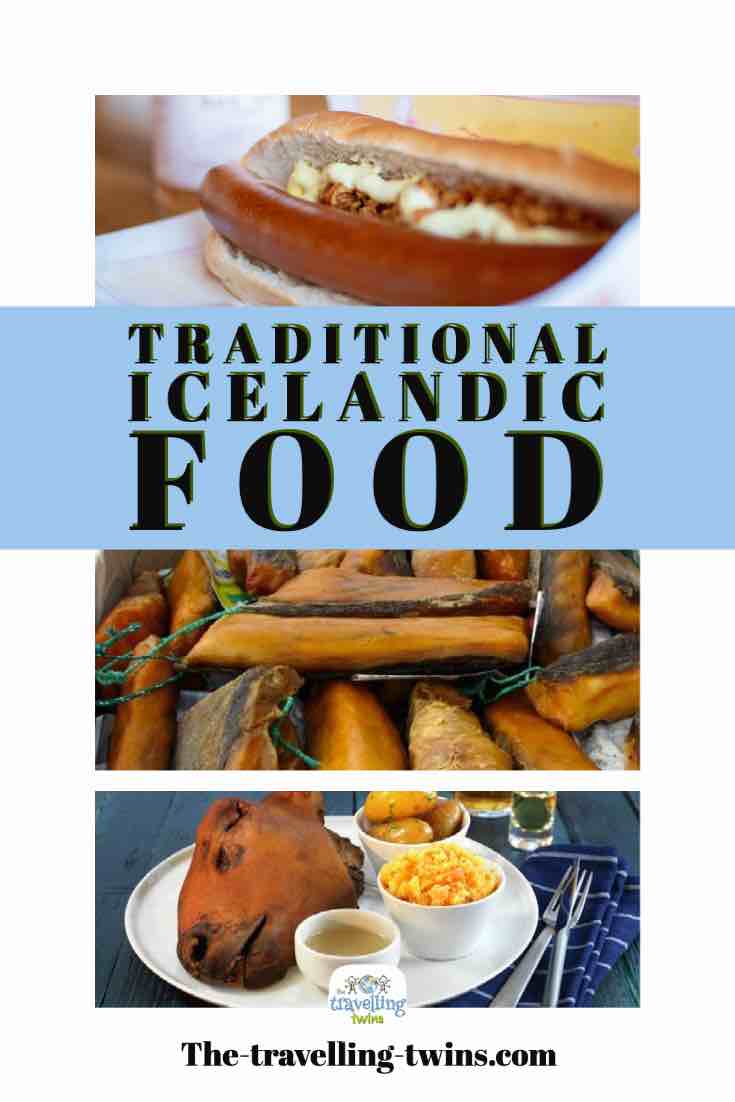Traditional Icelandic cuisine is based mainly on lamb, fish and seafood. Remember that until the late 20th century access to the island was limited to ships. Due to the difficulties in obtaining ingredients from overseas, Icelanders have achieved perfection in using the smallest scrap of locally available food. Thanks to this approach, some traditional Icelandic dishes fall into my category “weirdest food” rather than “favourite food” though others are particularly lovely (Skyr for example – Islandic yogurt) So please do try Icelandic Food when visiting Iceland . . . or at least read about it here!

Icelandic Fish
Iceland has over 340 species of saltwater fish swimming in its waters. That means that Icelandic fish is one traditional food that you should try, but not necessarily in the following order . . .
Hákarl – Fermented Shark
Hákarl is the most famous Icelandic dish mostly because eating it is a real challenge. The main ingredient here is Greenland shark, the meat of which is put through a process of fermentation by burying it in the ground. The meat is left to rot for about 6 months; then it is smoked. In some places, you will read that the shark flavour is enhanced with urine. I’m told that this isn’t true, though. The smell of ammonia is just because as the meat is rotten, so no problem there then! After the meat is cured it is hung outside for a few months to dry.

You can order shark meat in any Icelandic restaurants. The dish is quite expensive. Hákarl is often served with shots of Brennivin – high percentage, expensive, and (for me) totally disgusting alcohol. If you just want to try it, you can buy Hákarl in Bonus or many other Grocery Stores.
Harðfiskur – Dried Cod
Hardfiskur is a dried fish jerky, usually cod or haddock, which is extremely hard to bite and swallow. It is a popular snack eaten with butter. Consuming this delicacy, however, requires great determination and patience. Each bite demands intensive chewing and even so, needs chasing down with a beer or other stronger drink.

Hvalspik whale meat
Hvalspik is a dish of whale meat, and for me, that is enough reason to not want to try it. However, apparently, the Icelanders only make it from unthreatened species of minke whale or fin whales. The whale meat is usually served in the form of steaks or sashimi. you can also order whale steak – it is prepared in a similar way to beefsteak but tastes like tuna steak though more bloody.
I much more prefer Whale watching than eating.
Selshreifar – Pickled Seal Fin
Another Icelandic food which raises moral doubts. Selshreifar is made of seal fins. These are salted and then marinated in whey. Thankfully due to the limitations of seal hunting, this food is rarely on the menu, but still, you can find it in some restaurants in Reykjavík.
Gellur – Fish tongue
The Icelanders’ habit of eating offal is born of the scarcity of food in past times, and here is an example. Gellur is a fish dewlap, which is also called “fish tongues”. It is essentially a fish stomach stuffed with fish liver and other intestinal bits and pieces. I guess this makes it the Icelandic fish equivalent of haggis (which I love) The dish is especially popular in the north of the island.
Plokkfiskur
Plokkfiskur – again a traditional Icelandic food. Is a type of fish and potato puree with the addition of milk, flour and onion. The dish has been created to make the best use of the leftovers from previous days – in this case, cooked fish and potatoes. It doesn’t look very appetizing, but it tastes great.
To prepare the dish Icelanders use cod, halibut or other white fish. Plokkfiskur is served with rye bread (rúgbrauð) and butter. You can eat it from the dish or on bread in the form of a sandwich.
Icelandic lamb dishes
Svið – Sheep’s head
That’s another “no-no “in my opinion. I didn’t want to try it nor even look at it. Svið is a sheep’s head. I understand that they remove the brain but it is served with eyes, teeth and tongue in place. The head is boiled and singed with a flame before serving. Apparently, sheep’s head tastes like a pork knuckle, but the taste is not the problem; how the dish looks is the main stumbling block. You can try this dish in some restaurants in Iceland.

Slatur – Sheep black pudding
Slátur in free translation means a slaughterhouse and its name refers to the origin of the ingredients of the dish. It is, of course, another offal-fest. This peculiar blood pudding also contains sheep intestines, liver, kidneys, and stomachs. All the ingredients with the addition of bacon are tastefully sewn into the sheep’s stomach. Slátur can be served with boiled potatoes or rice with cinnamon. There is also a sausage version, – an offal sausage, covered with lard.
Kjötsúpa – Lamb Meat Soup
When we visited Iceland in winter we visited the Soup Festival happening in the streets of Reykjavík. We try there a traditional meat soup – Kjötsúpa “winter lamb soup”.
Kjötsúpa is traditionally made with various vegetables like potatoes, swede, and carrots, but can also contain cabbage, onions, leeks and garlic.
Hrútspungar (sour ram’s testicles)
Another Icelandic delicacy is ram’s testicles, which are most often boiled in water or vegetable stock. This dish is an unusual delicacy, widely recognized as an aphrodisiac. In restaurants, it is rather difficult to try, but those who are determined can taste an alternative version – a sausage made of finely chopped and properly seasoned testicles. You can easily buy this sausage in most Icelandic supermarkets.
Other traditional Icelandic foods
Lundi Puffin meat
The next place on our menu goes to the meat of the puffin. Although cute live puffins are part of the tourist image of Iceland, they are also loved for their value as food. Puffins are a favorite part of the island’s culinary assortment. These little flying creatures are often hunted, and their meat is served in most traditional restaurants. Puffin can be both cooked and smoked. The taste of the meat is similar to venison.

Lobster soup
One of the most popular shellfish in Iceland is the lobster. In many restaurants and street booths, a variety of dishes with lobster as an ingredient are popular, and the Icelandic lobster capital is Höfn on the east coast. In one of the local food booths I tried a creamy lobster soup, the sweet-salty, delicate taste of which I really liked. A great addition to the soup turned out to be an extremely simple and not very Icelandic dish – fish and chips.
Icelandic Breads
- Rúgbrauð
All the Icelandic bakery products I tried won my heart, but rúgbrauð was number one – dark rye bread with a characteristic slightly sweet aftertaste. It is great with just butter but also goes particularly well with fish (give me smoked salmon please!), cold cuts of meat, cheeses, and also in a sweet version – e.g. with jam and skyr.
Rúgbrauð is called Lava or Volcanic bread because it is traditionally baked buried in an underground, geothermal bakery (for about 24 hours), where the earth’s temperature reaches 100 degrees.
- Flatbrauð
Flatbrauð (flatkökur) – flat bread- just like rúgbrauð, is perfect for everything. It is a type of pancake that is usually served with butter, smoked lamb, hard-boiled and sliced egg or salmon.
Talking about the bread we should mention Icelandic butter which is so tasty that you can eat it with a spoon straight from the packet. I don’t know how they make it, but both Icelandic dairy and no-dairy butter spread are the best we ever tried.
Icelandic drinks
- Icelandic water
All tap water is pure and clear in Iceland. It is famously so – being sourced from ancient springs themselves replenished from ancient glaciers. Everyone drinks tap water here, so when visiting Iceland bring your own reusable water bottle from home – we couldn’t find them for sale anywhere – at least not for a reasonable price. Everything in Iceland is expensive, but bottled water and water bottles are both top-end – even for here.
- Brennivin – Black Death
Finally, I present alcohol, which is served with most of the dishes described above. Brennivín is a clear, unsweetened caraway potato vodka. This drink is sometimes called roasted wine or caraway wine, but most often you will find it on the menu under the dubious name of “Black Death”. I come from the land of perfect vodka, so I can’t get enthusiastic about Iceland’s version.
- Icelandic Beers
In Iceland you can try a variety of local brew beer, though still not so long ago Iceland 1985 beer was forbidden in the country – you can read more interesting facts about Iceland. And btw you will not buy beer stronger than 2.25% in supermarkets. Stronger beer is available on the island only through the alcohol network, Vínbúðin, or restaurants and pubs.
Other Question regarding Icelandic Food
What is the main Fast food in Iceland?
Icelandic Hot dog (pylsur) is the most popular street food in Iceland. Hot dogs stands are almost everywhere, the first one we saw was next to our swimming pool, but our favourite place and cheapest was IKEA, where you can get both vegan and meat versions with roasted or fresh onion, sweet mustard, ketchup and mayonnaise.
What is the Best things to eat for breakfast in Iceland ?
Skyr is a traditional Icelandic dairy product that resembles Greek yogurt or but is technically a homogenized cheese. It is much tastier – in my opinion than yogurt. I recommend it with berries or crunchy muesli.
Where to try Icelandic food?
Probably the best way to try a variety of Icelandic food is to visit a buffet in one of Reykjavik’s hotels. You can also try Cafe Loki which is famous for serving traditional Icelandic food. Here you can order Icelandic plate sets (Íslenskt góðgæti) – rúgbrauð (rye, slightly sweet bread) and flatkaka (flat bread) and several different Icelandic specialities such as sviðasulta (sheep’s head jelly), hangikjöt (smoked lamb), harðfiskur (dried fish) and for dessert – try rye bread ice cream.
What to eat in Iceland – Pin it for later



Privacy Policy Disclaimer
This website uses affiliate links for income and support.
If you like our website, please consider using these links. You will be directed to the vendor, and we will get a small commission on your purchase price at no increased cost to you.
We have researched facts stated here as far as practicable but please check anything critical before committing your time and money. We do not claim any special knowledge or expertise, and we are not consultants for our readers.